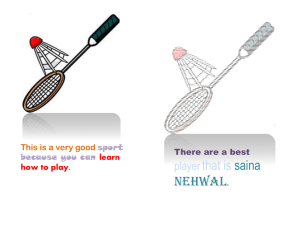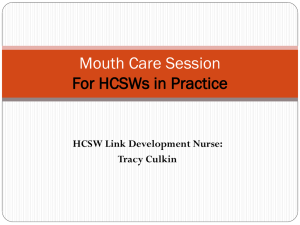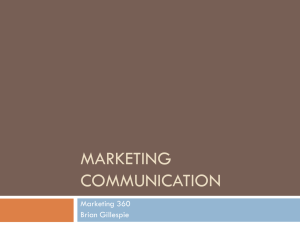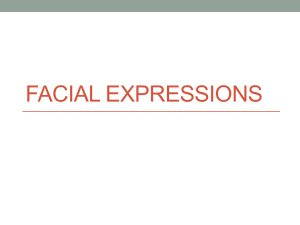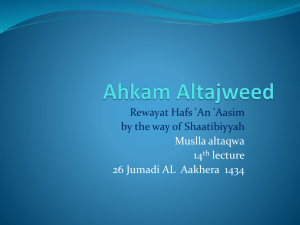Workshop 4 Presentation - End of Life Care Network
advertisement
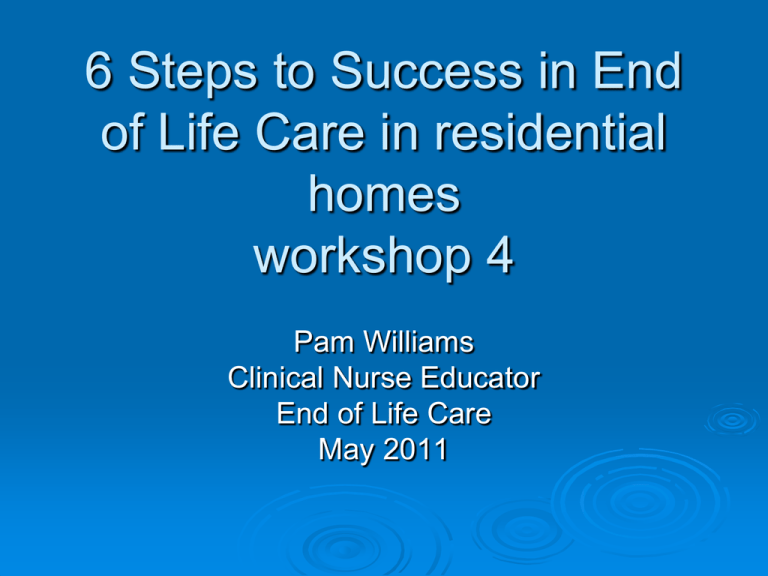
6 Steps to Success in End of Life Care in residential homes workshop 4 Pam Williams Clinical Nurse Educator End of Life Care May 2011 Objectives of the day Delivering high quality end of life care; Define ‘high quality end of life care’ Identify a training matrix template for all staff in EOLC, Recognise the importance of Significant Event Analysis What is high quality end of life care Comfort Support Environment Planning Expertise COMFORT Your experiences What provides comfort? What are the barriers to providing comfort for palliative & dying residents in your home? How can you overcome them? SUPPORT For staff For residents For families/friends Who and how? ENVIRONMENT Your What experiences are the barriers to providing the right environment for palliative & dying residents & their families in your home? What does the end of life care strategy say? Rooms where residents and families can talk privately Rooms where family can stay overnight with facilities for catering and communication What should we consider? First impressions- professional but reassuring Nature – natural materials and elements Beauty & arts and crafts Dignity & privacy Comfort Robustness economy And…. Free of clutter Good natural light and fresh air Information Conducive Is your notice board appropriate Hire a skip and have a decluttering day Ask yourself… Can residents exercise control over their environment? Can they adjust their bed? Do they have access to tv/radio/music? Have unwelcome sounds/smells been minimised? Can windows be opened? Can residents see the natural world from their bed? Are chairs provided for visitors? What can you do? Create a peaceful environment Give residents/families as much control over the environment as possible Maximise views of gardens etc Suitable lighting Ensure access to music/tv Ensure chairs are comfy for people staying for long periods of time Make sure the room is clean, tidy and pleasant Ask residents & relatives what they want! Planning & evaluating plans Learning Sharing your learning with colleagues Reflecting Using on plans learning to improve planning Training plans Think about the different groups of staff in your home How would you devise a training plan to meet all their needs What topics would you include Who would deliver the training When & how would that happen Consider as many types of training as you can EXPERTISE How can all care home staff access relevant end of life care training? Internal External What can I do next? Distance learning Elearning – skills for care/skills for health Diploma- (NVQ) Degree – Care of the Dying module Significant event analysis (SEA) The importance of reflection Other ways of reflecting Supervision Post death audit tool Lessons learned sessions Simple ways to maintain comfort Therapeutic Good touch mouth care Hospice therapy team The benefits of therapeutic touch. THE IMPORTANCE OF GOOD MOUTH CARE WHY IS GOOD MOUTH CARE IMPORTANT FOR OUR RESIDENTS? HOW DOES GOOD MOUTH CARE IMPROVE QUALITY OF LIFE? The structures of the face including lips & cheeks contribute to communication The tongue, palate & teeth serve a large number of functions including defence against infection, incision, chewing, signalling with facial expression & speech, Gestures for contact & grooming for love & affection Quality of life depends on keeping these functions intact as long as possible THE PATIENTS POINT OF VIEW Ability to communicate easily To taste & enjoy food & drinks To be nice to be near Dignity & self-respect SIGNS & SYMPTOMS Poor oral hygiene can contribute to poor appetite, leading to weight loss and malnutrition, and has also been associated with the development of aspiration pneumonia in the elderly. This can lead to the resident being identified as end of life prematurely. Symptoms of Poor Oral Hygiene Dirty mouth Furred tongue Sore, painful mouth Bad Breath Dry mouth Oral Candidiasis Viral Ulcers Excessive salivation ORAL CARE IN THE ELDERLY DEPENDANT PERSON As a person ages, the soft tissue around the teeth becomes harder making it harder for the individual to detect painful toothache. Older people are more prone to problems with the gums, salivary glands, lips, muscles and jaw bones. Also the amount of saliva and person produces, which helps to clean teeth, decreases with age, leaving the mouth more vulnerable to tooth decay and infection. Maintaining oral hygiene is very difficult for dependent elderly who cannot brush their teeth. They rely on you to do this for them! One of these patients has dementia and one has paralysis from a stroke Both of these patients were unable to maintain their own oral hygiene and has clearly been neglected by the people who should be helping them. Oral care in the final days People in the last 24-48 hours of life often have difficulty taking fluid, food or oral medication (Ellershaw et al, 1995) Symptoms of dry mouth & thirst are common in dying patients whether they are dehydrated or not. Reversing dehydration has little effect on symptoms for the majority of people (Ellershaw et al, 1995) Simple measures can be used as often as needed to maintain a moist mouth Frequent mouth care is used as often as necessary to maintain a clean & moist mouth. This can often be done by the family, giving them greater involvement caring for their relative Mouth wash containing alcohol is very drying to the mucosa End of Life Dying, semi/unconscious patients are unable to contribute to their own oral care They are also unable to swallow their own salivary secretions Excessive secretions can be treated with medication Oral hygiene is a vital part of end of life care- DIGNITY, RESPECT, COMFORT How do we maintain good oral care in dying patients? The prescribing of any oral care preparations you need are as vital as end of life drugsremember to ask the GP to prescribe these too! Use a soft, baby toothbrush & clean gently around the teeth, gums & tongue. Use a small amount of water or appropriate mouthwash on the toothbrush as you will be unable to rinse toothpaste out of the mouth. (unless you have access to suction & a Yanker suction catheter) Then apply any product/treatment currently in use i.e. nystatin Lips Finish off by wiping gently around the mouth Applying a moisturiser to the lips i.e. vaseline, to prevent dryness & cracking. Document the care delivered, recording date, time & signature If you feel confident to do so, you can teach family members to do this if they wish. Be sure to document this too and that they have expressed a wish to do this. Ask that they let staff know each time they have delivered oral care, for documentation purposes. And finally… Myth 1 teeth are just for looks Myth 2 its only a dry mouth- no big deal! Myth 3 resistance- its not worth it Myth 4 soaking dentures overnight is enough Dignity A parting thought! What do you see nurses? Small change - big difference Clean clothes & bedding & tidy room Good personal hygiene Respect for privacy Can everyone see packs of incontinence pads when visiting? Can everyone see photographs of pressure sores when looking in notes? The policy There is a process in place to identify the training needs of staff and staff will have access to end of life care training, particularly those involved in discussing end of life issues with residents & families. There is a process in place to reflect on end of life care and utilise lessons learned to provide continuous improvement. The environment within the care home offers privacy, dignity and respect for individuals and their families as end of life approaches. Objectives achieved? Define ‘high quality end of life care’ Identify a training matrix template for all staff in EOLC, Recognise the importance of Significant Event Analysis To do list Feedback to all staff contents of Step 4 workshop Complete an end of life care training needs analysis for all staff Review available options for accessing end of life care training locally and implement a training plan Commence the implementation of a Dignity Champion if not already identified within the home Review the environment and implement any necessary achievable changes. Bring to the next workshop any literature used within the home to support residents, relatives and significant others when residents are at the end of life Continue to complete the post death audit form Any questions?
